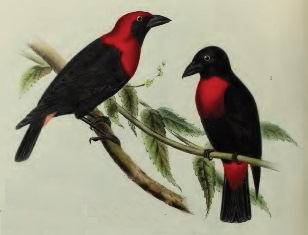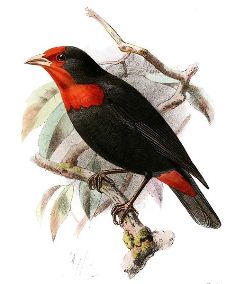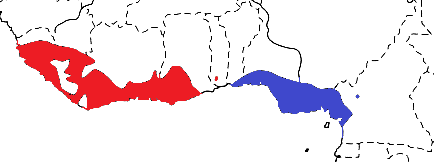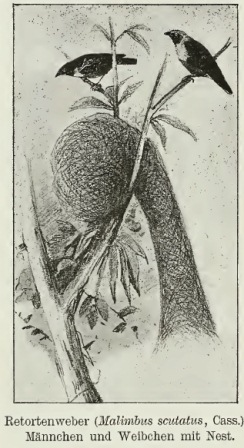Weaver Wednesday [46]: Red-vented Malimbe 2013-05-01 (360)
 Weaver Wednesday
Weaver Wednesday


The Red-vented Malimbe Malimbus scutatus is a common weaver in West African lowland forests. It has a red breast and vent - the red vent with black belly separates it from all other malimbes of any age or sex. The male Red-vented Malimbe also has the crown and nape red. The immature has a pale bill. The species was first described by John Cassin, who also published the first illustration of the adults (above left). George Shelley described what he thought was a new malimbe as Malimbus rubropersonatus, but later he realised that it was an immature Red-vented Malimbe (above right).

Two subspecies of the Red-vented Malimbe are recognised (see map right, based on Birds of Africa):
M. s. scutatus from Sierra Leone to Ghana, with 2 sightings from Togo in 1990 (see red on map).
M. s. scutopartitus, from Benin to SW Cameroon (see blue on map). This race is slightly larger, and the red breast band is broader in both sexes, and is split by a black line in the female.
The Red-vented Malimbe inhabits mature and secondary forest, small and large forest clearings, forest edges, gallery forest, swamp forest,
and well-wooded savanna. It is closely associated with palm trees, living near and nesting in them in both forest and open, cultivated
land and around villages. It keeps mainly to the upper strata in forest, foraging higher than any other malimbe. It is found in pairs or groups of up to 5 adults. It sometimes joins mixed-species foraging flocks of insectivorous birds. Non-breeding birds roost at night in their
old nests. Food consists of insects, including caterpillars, obtained by gleaning and sometimes by aerial sallies; it also feeds on husks of oil palm nuts.

Red-vented Malimbe nests are often alone but sometimes 3-7 are found together, but only one is occupied. The nest is a neatly woven 'inverted sock' with a globular egg chamber and long entrance tube. The nest was first illustrated by J Buttikofer in 1890 (left). The entrance tube is semi-transparent and beautifully woven - it looks delicate but is remarkably robust. The tube length may be up to 64 cm long, but is usually shorter. An adult arriving in flight dives upward into the entrance with closed wings, and grasps it inside with its feet and then clambers up to the chamber. The nest is built by both sexes, and is typically suspended from the centres of 2 adjacent palm leaflets, or the tips of the leaflets. Nests are often placed in palm trees. One nest took 21 days to complete.

The Red-vented Malimbe has 1 PHOWN record from Ghana. Many more PHOWN records are needed for this species (see PHOWN summary). Submit any weaver nest records to PHOWN (PHOtos of Weaver Nests) via the Virtual Museum upload site.
PHOWN summary
Previous Wedn: Golden Palm Weaver
Full weaver species list
|


 Weaver Watch
Weaver Watch


